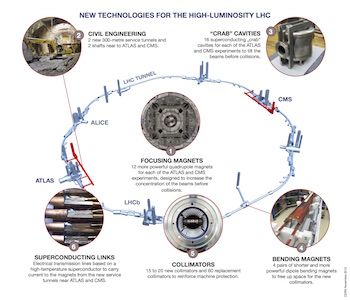Faculty, students help design, build next-generation detectors to unfold nature’s secrets
Rice University scientists are preparing to do their part to help dramatically increase the capabilities of the Large Hadron Collider (LHC), the world’s most powerful particle collider. The European Organization for Nuclear Research (CERN), has announced it will move forward on a plan to dramatically increase the LHC’s luminosity, which will boost its ability to discover new elemental particles.

A graphic shows an upgrade that will improve the luminosity of the Large Hadron Collider. Click on the image to see a larger version. Courtesy of CERN
The Rice team led by physicist Karl Ecklund is already thinking hard about what the LHC will require as it ramps up to explore nature by studying its most basic structures. The LHC smashes together protons at near light speed, and the exotic particles that fly from these collisions help physicists answer fundamental questions about matter and the universe. After upgrades are completed in 2025, the LHC will produce 10 times more collisions than it did in 2012. This will allow for more accurate measurements and increase the odds of answering questions about the likes of dark matter and supersymmetry.
“‘Luminosity’ is a word we use in particle physics to characterize how many collisions we have per second,” Ecklund said. Currently, the LHC at full power produces about 1 billion collisions per second. The upgrade, he said, will feed more protons into the energy stream that races around the collider and will use more powerful superconducting magnets to achieve a tighter focus of the stream.
Rice’s part includes the development and construction of improved tracking detectors for the Compact Muon Solenoid (CMS), one of two major experiments attached to the LHC, a 17-mile ring buried beneath land that borders France and Switzerland. The 13,000-ton CMS finds and characterizes the particles produced by collisions.
For many years, Rice physicists and their students have designed and built components for the CMS. Among the debris that spreads from the collisions, they find evidence of particles that may live for only minute fractions of a second, but whose properties, they suspect, allow our universe to appear as we perceive it. The speed, paths and lifespans of these particles provide clues to their identities.
The CMS website describes its detector as “a cylindrical onion” whose various layers can detect different particles. Because the upgraded LHC will produce much more data, the detectors will need to be smarter, said Ecklund, who is co-leading institutional collaborators in the United States working on the tracker upgrade.
He described CMS tracker elements as “fancy versions of a camera detector,” but much larger. Many of these trackers wrap the chamber where collisions happen. “Part of what we need to do is improve the trackers’ ability to select which events (particle detections) we want to keep. The tracker will have some capability of deciding in real time if an event was interesting enough to keep the data.”
The most sought-after particle found so far is the Higgs boson, predicted by the Standard Model of physics but undetected until 2012. The LHC, restarted at greater power for a second “season” this summer, is expected to refine knowledge about the Higgs in the next year or two. Much of that data will come from the CMS.
Ecklund said the latest announcement is the result of the international parties reaching an agreement on how to move forward with the collider’s development, even though many details have yet to be determined. Much of what Ecklund and his colleagues do now will depend on what the LHC finds in the next couple of years.
“The basic idea is to continue searching for particles we don’t know about yet, but also to study the newest stuff, like the Higgs boson, and try to understand what makes it tick,” he said.
He said the LHC was originally geared toward discovering the Higgs. “But it was also designed as a more general-purpose instrument, like the Hubble Space Telescope: ‘Let’s point it out there and see what we find,'” Ecklund said. “We might also have the chance of discovering something new in the next few years, before we get to the upgrade. Whatever that might be, we’d also like to study it.
“We’re hoping we see a host of new and interesting things,” he said. “Every time we’ve probed the Standard Model or other theories, we usually end up answering one question that immediately poses several more. So there’s not ever really an end, usually just a beginning of another chapter of inquiry.”



Leave a Reply